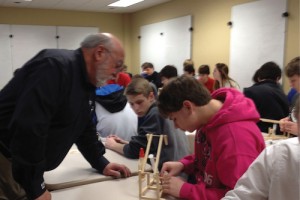Edited by: Mike Santora • Associate Editor
NFPA Chairman Jeff Stuart expressed earlier this year that the organization and its Board of Directors are increasing its focus on a set of clear, high-level objectives. These objectives, referred to as “ends” statements, describe the major ends or outcomes the NFPA wishes to achieve. Of the six statements, three of them deal exclusively with what the NFPA membership consistently ranks as its number one challenge: growing the fluid power workforce. Those statements are:
• NFPA fosters awareness and involvement of middle and high school students, helping them to understand fluid power’s potential as a technology and choose fluid power as a career path.
• NFPA helps increase the number of technically trained people capable of integrating and applying fluid power, and connects them to careers in the fluid power industry.
• NFPA supports universities in the development of fundamental fluid power knowledge and connects the industry to an increasing number of scientific and engineering leaders in the field.
At its most recent meeting in October 2015, the NFPA Board again deepened its focus in these three areas, recognizing both the success in each, and advancing several new program concepts that could help move the needle even further.

The NFPA’s Student Career Connections Program offers a way for companies to connect with students, make them more aware of fluid power careers and get more involved with the community.
For middle and high school students:
• Fluid Power Challenge. This middle school student program has established itself as the NFPA’s primary outreach activity to young people. Last year, 1,450 middle school students participated in 14 Fluid Power Challenge events, where they built fluid power mechanisms out of simple materials and operated them in a series of timed competitions.
• High School Fluid Power Challenge. With such success at the middle school level, the NFPA saw the need for developing a companion program for the high school environment. Many engineering competitions and curricula exist for these STEM-minded high school students—FIRST Robotics, SkillsUSA, Project Lead the Way and the Student Career Connections Program being just a few examples.
For technically trained people:
• Center for Advanced Fluid Power Technical Education. NFPA’s focus on 2-year technical schools and community colleges is increasing substantially as it recognizes the pressing need for more employees with the technical degrees and skills that these schools provide.
For universities:
• Center for Compact and Efficient Fluid Power. NFPA’s partnership with the CCEFP, a network of fluid power research laboratories, academic faculty and students at seven universities, continues to grow. Since its inception in 2007, the CCEFP has added more than 100,000 ft lab space to its universities. The CCEFP has increased fluid power advanced degrees by more than 500%, increased the number of fluid power educators by a factor of 10, and engaged more than 13,000 university students in a variety of workforce development programs.
• National Fluid Power Engineering Challenge. Building on this success, the NFPA is now exploring support and expansion of a fluid power-themed national engineering challenge, to be conducted by teams of undergraduate engineers at our nation’s universities. Many of these competitions exist, and have become an engaging staple of the under-graduate engineering environment, giving students both exciting opportunities to explore and apply their developing skills and to connect with particular technologies and industries.
NFPA
nfpa.org
Filed Under: Fluid Power World Magazine Articles